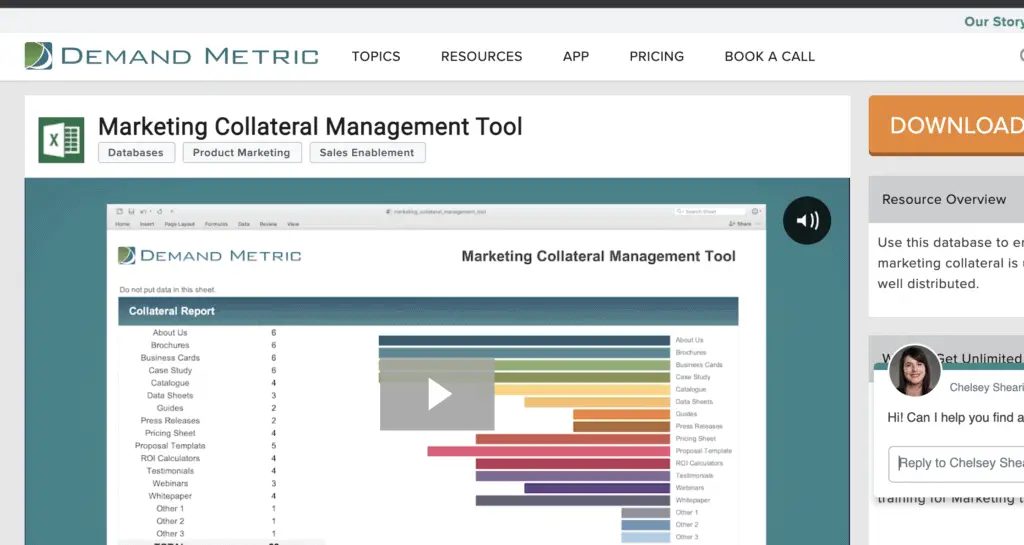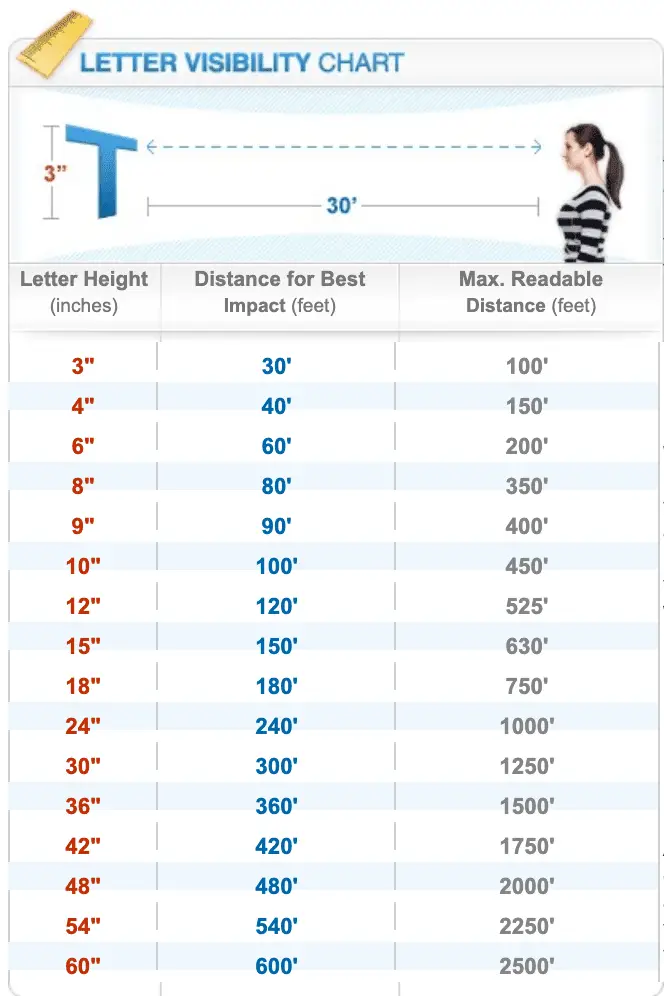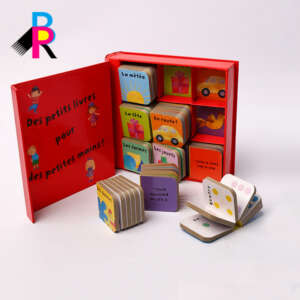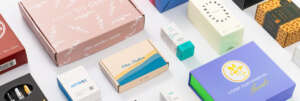THE BEST MARKETING MATERIALS FOR SMALL BUSINESS

- The BEST Marketing Materials for Small Business
- What are marketing materials?
- Why Marketing Materials Still Matter
- Try These Quick Start Tips to Develop Your Marketing Materials
- How to Use Your Marketing Collateral
- You’ll Need a Marketing Collateral Distribution Tool to Manage Everything
These days traditional print marketing has been put on the back burner. That’s too bad. Just because everyone is walking around with a mobile device, doesn’t mean that traditional marketing materials don’t work for small businesses.
In this article, you’re going to get a list of the best marketing ideas that you can use to create marketing materials for your business.
Let’s dive right in.
What are marketing materials?
Marketing materials cover a wide range of items that communicate your marketing message to customers. Effective marketing materials serve as a reminder to call your company and use your services. These items may include printed products like business cards, brochures, presentation folders, and catalogs. Signs, banners, and even billboards can be classified as marketing materials. Other promotional items, like t-shirts and coffee mugs, are other examples.
Why Marketing Materials Still Matter
Most small businesses don’t have the luxury of hiring sales people. This is where well developed and thought out marketing materials can do that job.
Content marketing includes all kinds of content, and marketing materials are content. Often, they are printed content, but that counts.
Customers want to hold and reference marketing materials about high-value purchases.
Out of sight. Out of Mind. This phrase doesn’t just apply to people, it applies to conversations and product information. Websites disappear from your screen but paper tends to stick around.You search for information or pricing and then something gets in the way and suddenly the page you were looking at is gone.
If you sell a high-priced or high-value product, you want to have printed marketing materials. Here’s why.
Printed marketing materials tend to float around. Not only that, but if you’re selling a “high involvement” product — something that’s expensive or important such as a furnace, or a high-priced service, your customer will want to have that information close at hand.
Printed marketing materials get passed around.
One of the great things about marketing collateral is that they have a long “shelf-life” – and get passed around from one prospect to another.
Think of them as additional advertising or support for folks who refer you to their friends and family.
If you use direct marketing to sell your product or service, you want to make sure that all of your best and ideal customers have information about your company in their hands.
Marketing collateral supports and builds your brand.
Well-designed and well-written collateral will make your brand stand out from the competition and they will make your brand widely visible. Here are 9 marketing material ideas you can use at networking events.
The key to success is making sure that your brand is consistent across all of your business materials. Here are just a few tips:
- Make sure that your logo and logo colors are consistent across your business cards, brochures, letterhead, envelopes, etc.
- Check your fonts! Your business brand should have an official font for the logo, for letterhead and across all of your printed materials. Be sure to have a consistent font for headlines, for copy and for captions under any images.
- Use consistent imagery. If your brand is using photos, then keep using photos across all of your marketing materials. Don’t mix and match photos with illustrations.
- Check the addresses on all of your marketing collateral — if you’ve moved or changed, you’ll want to re-print them.
- Re-read and review all of your materials to make sure that your products and services are still current.
Try These Quick Start Tips to Develop Your Marketing Materials
Be consistent with your brand! Make sure that you’re using consistent colors, fonts and images.
There are so many great resources for putting all of these items together.
TailorBrands is a DIY Marketing tool that you can use to create your basic branded materials.

99designs is another option of you’d like to work with a professional designer.

No matter what resource you decide to use, get a “style guide” or “brand book” that you can reference.
Here’s an image of the DIYMarketers Style Guide so that you can see how simple it is.

This is the DIYMarketers Style Guide. I share this with designers and team members to make sure all of our materials have a consistent look and fee.
How to Use Your Marketing Collateral
And now for the good stuff.
Here’s my list of 19 types of marketing materials that are ideal for small businesses. I’ve grouped these materials into five categories. I’ve also placed these categories in order of the marketing and buyer’s journey. This goes a long way toward helping you understand exactly how you can use each type of marketing material.
Tips on How to Use Small Business Brand Building Marketing Materials
Every small business has these brand basics but most don’t leverage them for maximum branding exposure. Unfortunately, most of these materials are taken for granted and often relegated to boxes in the back of the supply closet. Here are a few creative ways to use these staples of materials.
Examples of Creative Paper Marketing Pieces
Here is a list of general business marketing suppliers and printed materials that you should always keep updating. I don’t recommend that you spend a ton on these.
1. Business Cards
- Add your logo and tagline to your business cards
- Be sure to include an email address with your business domain. [email protected]
- Use that valuable back-of the-business card real estate as an appointment card, price list, or print something unique and memorable about your business.
- Include extra business cards in every correspondence so that customers can refer you.
- Use a version of your business card as a sticker for envelopes.
- Add your social media URLs to the card (not just the logos).
- Put a short survey on the back of your business card
- Keep a list of referral partners and give them enough cards.
- Include in invoices and correspondence and bags.
- Add your price list to the back of the card.
- Put helpful info on the back.
- Add a coupon on the back.
- Place a promotional offer on the back of the card i.e. free consultation.
- Leave your card in relevant businesses i.e. banks, libraries.
2. Letterhead
- Is there a phrase or tag line that you always use in your business? Slap it on the letterhead and the envelope.
- Send personal letters/notes to customers on letterhead
- Create a letterhead design that makes your sales presentations pop.
- Use letterhead for printing invoices.
- Create notecards as letterhead for more information communication
- Send direct marketing mailings on letterhead and insert brochures, coupons, etc.
3. Envelopes
- Match your envelopes with your letterhead.
- Add unusual script or text on your envelopes to make them stand out.
- Consider larger branded envelopes for presentations.
4. Brochures
- Match brochures with your brand design
- Have a basic brochure and create additional brochures for different groups of customers or for different products
- Include call-to-action information so prospects can order: email, order landing page, phone, address – across the bottom.
- Include any instructions on how to buy or place an order.
- When you update brochures, send them out to customers along with a friendly letter on your letterhead. Your customers will love it.
- Create a block of text that contains contact info for questions.
- Put clear offers at different price points to entice new customers.
- Be sure to add a copyright to designate “rights reserved”
By far these cheap marketing materials for small business should cover 90% of your print marketing.
5. Outdoor Signs
- If you have an outdoor sign, make sure that it’s in good shape; lights working, letters and writing visible from a distance.

(Source Signazon.com)
- Keep outdoor signs simple and eye-catching
- Stay away from ALL CAPS – use a mix of fonts in different styles or sizes.
- Define the purpose for your outdoor signs and stick to it.
- Be specific about your offers- what, how much, until when.
- Add point-of-purchase signs to drive customers to featured products.
- Use window decals to clearly display hours of operation.
- Add humorous or colorful outdoor tent signs featuring specials.
Tips on How to Use Sales Presentation Materials
The next phase of the sales and marketing process is to educate your prospects. This set of materials is especially handy for high-involvement purchases (such as industrial machinery or high-end home purchases).
While I’m featuring printed collateral here, all of these materials are easily adapted to your digital marketing as well.
Treat these as content marketing.
That means your primary focus is the customer and what information they need to make a good decision (and choose YOU over the competition).
6. Case Studies
- Choose examples from ideal customers that feature your most profitable. products and services.
- Write case studies with a focus on the problem being solved and how you solved the problem.
- Keep case studies short and to the point.
- Use your customer’s words instead of industry jargon
- Add visuals and graphics
- Place case studies on your website.
- Link to case studies from your content.
- Add clearly visible or “slide in / pop up” calls-to-action.
- Put case studies on your home page – you can change them regularly.
- Include a feedback or chat box.
- Pull testimonial quotes from case studies and feature them on your home page.
- Create articles, blog posts, infographics from case studies and promote on social media.
- Create videos from your case studies.
- Post your case studies on social media.
- Use case studies in your email marketing.
7. Sales Sheets / Product Sheets
- Use your branding style sheets and fonts.
- Make fonts and colors are easy to read.
- Feature your USP for each product or service.
- Focus on your marketing message in product descriptions.
- Include client and customer testimonials.
- Explain or show product applications.
- Create “Offer Tables” that spell out what’s included at different levels.
- Include pricing information or links to pricing information.
- Spell out what level of support is offered for each product or service.
- Include links to product order pages.
8. Presentation Folders
- Create a useful or interesting folder – perhaps as an envelope.
- Make sure folders are big enough to fit all of your collateral.
- Use your folder as a selling tool by Including an infographic that features a chart or table about your products and their applications.
- Include contact information, calls to action and links to specific landing pages where they are easily found.
9. Testimonials
- Use your company name and brand name in every testimonial.
- Select those testimonials that speak directly to your USP.
- Match testimonials to specific products or services.
- Feature relevant testimonials on website product pages.
- Create “pop up” testimonials along with a call-to-action.
- Be sure to collect testimonials that speak to your outstanding customer service.
- Feature testimonials on your Facebook Pages.
- Take pictures of written testimonials and upload them as images on your “Google My Business” page.
- Encourage online reviews from customers.
10. Slide Deck
- Have a custom-branded slide template for everyone to use.
- Create a branded signature talk to post on LinkedIn that features your marketing message and typical problems solved.
- Include a basic call-to-action for the audience to download the presentation and a free resource.
- Prominently feature an irresistible offer for sharing.
11. Explainer Video
- Convert your slide deck into a 90-sec explainer video.
- Include a link to your video on your business cards and brochures.
- Incorporate your video into sales presentations.
- Include a link to a video.
- Include a link to a sales page where customers can place orders.
- Share your explainer video on social.
Conversion Focused Materials
Your marketing materials are like a 24/7 sales rep who is there to speak on behalf of your business. So make sure that you’re adding all the information your customer will need to contact you and buy from you.
When creating your flyers, postcards and menus keep customer conversion at the front of your mind. Put yourself in your customer’s shoes. Then, imagine your customer with one of these objects in their hand.
- What problem is your customer solving?
- How have they tried to solve the problem?
- What is your unique way of solving that problem?
- What’s the payoff or benefit to your customer?
- What action do you want them to take?
12. Flyers
- Create a branded flyer template.
- Print professionally on glossy heavy paper.
- Create flyers for each customer segment.
- Use flyers for special offers.
- Create informational flyers for specific products or services.
- Add customer testimonials to flyers.
- Add coupons or free offers to flyers to entice foot traffic.
- Staple customer receipts to flyers and place in a bag.
- Mail new flyers to customers inside invoices or other communication.
- Create a PDF of your flyer and send links to customers via email.
- Distribute your flyers to complementary local businesses.
- Mail to customers.
- Visit neighborhoods to deliver or leave at door.
- Post online on Instagram or Pinterest.
13. Postcards
- Create a branded postcard design that complements your brochures, cards, etc.
- Use postcards as invitations to special customer or neighborhood events.
- Feature a lead magnet such as an ebook or checklist and invite opt-ins.
- Feature a new product or service and take early orders.
- Use testimonials on your postcard.
- Get new customers using a targeted mailing list or USPS EveryDoor Direct Mail (EDDM).
- Distribute postcards to local businesses.
14. Menus
- Add a story about your business.
- Make them EASY to read. Use larger fonts.
- Avoid overlays or print screens.
- Stay consistent with your brand.
- Create PDF or printable menus to download. Invest in great descriptive menu copy.
- Post your menu on Facebook, Instagram and Pinterest.
- Post pictures of your menu items on social.
- Encourage customers to post their orders on social – have them add a hashtag or mention you for a discount.
Customer Support Materials
A lot of businesses either skip or skimp on these elements. But adding at least one of these to your customer support materials can improve customer loyalty and drive referrals.
15. Thank You Cards
- Invest in professionally printed and branded thank you cards.
- Add a handwritten note.
- Include a Thank-You gift, product sample or gift certificate.
- Send cards after – a referral, a problem you solved, a big order.
16, Loyalty cards
- Most loyalty is online, stand out with a “hard” loyalty card or gift certificate.
- Print high-end, gift certificates
- Send out $25 – $50 gift certificates to existing customers. This encourages them to come back and bring someone.
17. Posters
- Create posters about how your business makes your customers “feel”.
- State your message in as few words as possible (no more than 5).
- Use posters as a decorative feature in your offices.
- Highlight your company values and mission.
- Feature employees.
- Feature customers and add a testimonial.
- Craft an irresistible offer and make a poster out of it. (Think value-meal).
- Choose the right location – make it relevant.
- Create posters focused on how you serve customers.
- Put your company info and relevant URLs at the bottom of the poster. Make it visible and easy to find.
- Create artistic posters and use them as promotional awareness builders.
18. Catalogs
- Develop a concept for your catalog.
- Match your brand.
- Create a mini-featured product catalog or flyer.
- Make sure your catalog copy has a voice and point of view.
- Make it fun to read.
- Create a theme for the year/season.
- Feature customer in your images.
- Feature your target or ideal customer.
- Include customer reviews and testimonials next to featured products.
- Dedicate a section to customer service and support.
- Print all relevant customer service contact information, web sites, emails, phone numbers.
- Mail your catalog to existing customers.
- Send catalogs to your prospect lists.
- Mail your mini catalog to prospects (buy a targeted mailing list).
Examples of Promotional Marketing Materials
Promotional materials — aren’t just for trade shows! Think of promotional marketing materials as reminders and prompts for prospects to become customers.
Get more return on your investment from trade show promotional products by incorporating them throughout your whole business.
19. T-Shirts
- Optimize your log or create an icon. of your logo that is easily embroidered or printed on clothing.
- Select approved clothing items that can have a logo, tagline or other branded language
- Trip the reciprocity trigger with branded clothing gifts to prospects.
- Print a special offer on branded clothing and have everyone wear it for a period of time.Encourage employees to wear branded clothing at work and in their personal life.
20. Promotional Products: pens, mugs, keychains, etc.
- Spread the visibility of your brand to other useful items – beyond pens and mugs i.e. battery chargers, notebooks, etc.
- Have a collection of branded items when customers visit for them to take home.
- Create a branded basket as a customer or prospect gift.
- Include a phone number or extension and contact info where people can call to get help and support.
- Give out branded promotional products throughout the community – church, schools (who always need materials), sports teams, etc.
You’ll Need a Marketing Collateral Distribution Tool to Manage Everything
Honestly, I’ve never heard of the phrase “marketing collateral distribution” but it’s a thing, and whether you’re a solopreneur or you have a team, you’re going to need a way to keep track of your print marketing materials.
I’ve found two marketing collateral tools to keep track of your print marketing materials so that you can keep your brand consistent and know when it’s time to update.
Use this Excel Template

Demand Metric has this wonderful excel template that will help you keep track of when you should update your print marketing materials. It’s free if you register.
OK, so you’re inspired and ready to get going!
Source:diymarketers.com




